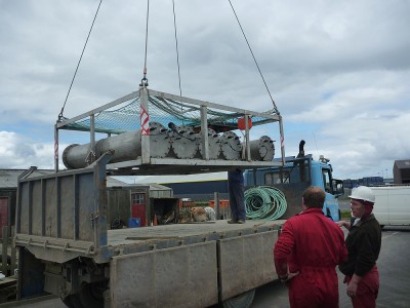
Renewable energy from tidal currents can be harnessed using large turbines fixed to the seabed. A consortium of UK scientists, working as part of the FLOWBEC project (Flow and Benthic Ecology 4D), is investigating the environmental effects of such devices by monitoring environment and wildlife behaviour at UK test sites, the first of which is the tidal energy test area of the European Marine Energy Centre (EMEC) in Orkney.
FLOWBEC is a National Oceanography Centre (NOC)-led project, which is funded by the Natural Environment Research Council and Defra (the Department for Environment, Food and Rural Affairs). It brings together scientists from the Universities of Aberdeen, Bath, Edinburgh, Exeter, Plymouth, Queens University Belfast, Plymouth Marine Laboratory, Marine Scotland Science, EMEC, and one of the world’s leading tidal turbine developers, OpenHydro Ltd.
Physicists from the University of Bath have helped build a special sonar system mounted on a seabed frame placed within 25-metres of an OpenHydro tidal turbine structure. This monitors fish and diving seabirds that pass through or feed within the location; in particular, the study is assessing how fish and seabirds interact with the turbine installation.
The sonar system was mounted onto a frame that was placed on the sea bed near the tidal energy turbine
The researchers are working with marine biologists from the University of Aberdeen to identify the wildlife detected by the monitoring systems and investigate any changes in behaviour caused by fluctuations in the current, waves or turbulence.
A marine radar, deployed by the NOC, has also monitored activity on and above the sea surface, mapping the extreme currents and waves at the site and tracking the behaviour of birds and marine mammals in the immediate area.
The FLOWBEC team deployed both devices at the EMEC tidal energy test site near Eday in the Orkney Islands for two weeks at the end of June and have begun processing the data.
“Using waves and tides as a renewable energy source is more predictable than solar or wind energy, and of course there isn’t the same visual impact. Tidal energy devices alter the local water flow and this project aims to measure and assess whether this has an effect on the wildlife around it,” explains Dr Philippe Blondel, Senior Lecturer in Physics and Deputy Director of the Centre for Space, Atmosphere and Ocean Science at the University of Bath.
“We’ll be sharing the knowledge gained with other users and providing data as an open resource for environmental scientists at the end of the project. Our presentation of the first results at the European Conference in Underwater Acoustics, a few days after recovery of the data, has been extremely well received by operators and researchers working with marine renewable energies.”
Dr Beth Scott, Senior Lecturer in Marine Ecology at the University of Aberdeen adds that the data obtained from the instruments will determine how mobile animals, such as seabirds and their fish prey, behave around marine renewable devices over an entire fortnightly tidal cycle. “This research will help to determine the actual risk of collision between marine animals and turbines and will allow governmental marine spatial planners a step change in the level of certainty about where to allow renewable developments,” she says.
Dr Paul Bell, a marine physicist at the NOC who is leading the project, said: “This is a truly multidisciplinary study bringing together researchers from all over the UK to shed light on how extracting wave and tidal energy from our oceans might affect the environment. If there are effects they could be beneficial to wildlife – but if any are negative, our research may suggest ways of avoiding them in future designs.”
[Inset: Sonar system mounted onto a frame prior to being installed near the tidal energy turbine at EMEC]
For additional information:

